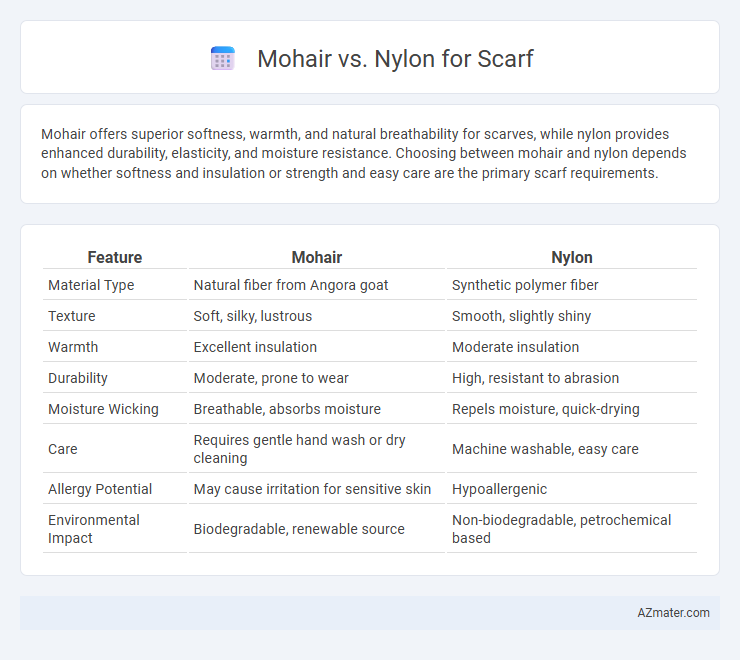Mohair offers superior softness, warmth, and natural breathability for scarves, while nylon provides enhanced durability, elasticity, and moisture resistance. Choosing between mohair and nylon depends on whether softness and insulation or strength and easy care are the primary scarf requirements.
Table of Comparison
| Feature | Mohair | Nylon |
|---|---|---|
| Material Type | Natural fiber from Angora goat | Synthetic polymer fiber |
| Texture | Soft, silky, lustrous | Smooth, slightly shiny |
| Warmth | Excellent insulation | Moderate insulation |
| Durability | Moderate, prone to wear | High, resistant to abrasion |
| Moisture Wicking | Breathable, absorbs moisture | Repels moisture, quick-drying |
| Care | Requires gentle hand wash or dry cleaning | Machine washable, easy care |
| Allergy Potential | May cause irritation for sensitive skin | Hypoallergenic |
| Environmental Impact | Biodegradable, renewable source | Non-biodegradable, petrochemical based |
Introduction: Mohair and Nylon for Scarves
Mohair, derived from the Angora goat, offers luxurious softness, warmth, and a natural sheen ideal for high-quality scarves. Nylon, a synthetic fiber, provides durability, elasticity, and resistance to abrasions, making it a practical choice for long-lasting scarf wear. Combining mohair and nylon in scarves balances comfort and strength, optimizing both aesthetics and functionality.
Origins and Characteristics of Mohair
Mohair, derived from the Angora goat native to Turkey, is celebrated for its luxurious softness, natural sheen, and exceptional insulating properties, making it a popular choice for high-quality scarves. Unlike nylon, a synthetic polymer produced from petrochemicals, mohair is a natural fiber, offering superior breathability and moisture-wicking capabilities. Its resilience and ability to maintain shape over time distinguish mohair scarves as both durable and elegant winter accessories.
Properties and Benefits of Nylon Fiber
Nylon fiber offers exceptional strength and durability, making scarves highly resistant to wear and tear compared to mohair. Its lightweight and elasticity provide a comfortable, wrinkle-resistant fit that maintains shape over time. Nylon also boasts excellent moisture-wicking properties, keeping the wearer dry and enhancing overall comfort in various climates.
Softness and Comfort: Mohair vs Nylon
Mohair fibers are renowned for their exceptional softness and natural warmth, making scarves feel luxurious and gentle against the skin. Nylon, a synthetic material, tends to be less breathable and can sometimes feel less soft, though it offers durability and stretch. Scarves made from mohair provide superior comfort, especially in cold weather, due to their lightweight warmth and smooth texture compared to the often less cozy nylon alternatives.
Durability and Longevity Comparison
Mohair fibers are highly durable due to their natural resilience and ability to retain shape, making mohair scarves resistant to wear and pilling over time. Nylon, a synthetic material, offers exceptional tensile strength and abrasion resistance, contributing to long-lasting scarf durability, especially when blended with natural fibers. Scarves made from mohair blend with nylon combine the softness and insulating properties of mohair with the enhanced durability and longevity of nylon, resulting in a scarf that withstands frequent use and maintains its appearance longer.
Warmth and Insulation Capabilities
Mohair fibers, derived from the Angora goat, provide exceptional warmth and insulation due to their natural crimp and hollow structure, which traps heat effectively. Nylon, a synthetic fiber, offers moderate insulation but lacks the breathable warmth and moisture-wicking properties of mohair. Scarves made from mohair deliver superior heat retention, making them ideal for cold climates compared to the less insulating nylon alternatives.
Moisture Wicking and Breathability
Mohair fibers excel in moisture-wicking due to their natural ability to absorb and evaporate sweat, keeping the skin dry and comfortable, while nylon tends to trap moisture, leading to less breathability and potential discomfort. The airy structure of mohair enhances breathability, promoting better airflow compared to the synthetic, less porous nature of nylon. Mohair scarves provide superior temperature regulation for active wearers by efficiently managing moisture and ventilation.
Allergy Considerations and Skin Sensitivity
Mohair, a natural fiber from the Angora goat, is generally hypoallergenic and less likely to cause skin irritation compared to nylon, which is a synthetic material prone to trapping heat and moisture, potentially triggering allergic reactions. People with sensitive skin often prefer mohair scarves for their softness, breathability, and reduced risk of itching or rashes. In contrast, nylon scarves can exacerbate skin sensitivity due to their non-breathable nature and potential to cause sweat-induced irritation.
Sustainability and Environmental Impact
Mohair is a natural fiber derived from the Angora goat, offering biodegradability and renewable sourcing, while nylon is a synthetic fiber produced from petrochemicals with significant environmental drawbacks such as high energy consumption and non-biodegradability. Mohair's production supports animal farming practices that can regenerate soil and promote biodiversity if managed sustainably, whereas nylon contributes to microplastic pollution and greenhouse gas emissions during manufacturing and disposal. Choosing mohair for scarves reduces reliance on fossil fuels and decreases long-term environmental harm compared to nylon alternatives.
Cost, Availability, and Style Choices
Mohair scarves typically cost more due to the luxury fibers harvested from Angora goats, whereas nylon scarves are far more affordable and widely available in mass-market stores. Availability of mohair is limited by seasonal harvesting and specialized production, making these scarves less common compared to synthetic nylon options found in nearly every retail outlet. Mohair offers a rich, natural sheen and a variety of textured styles appreciated in high-end fashion, while nylon scarves provide vibrant color choices and durability suitable for casual, everyday wear.

Infographic: Mohair vs Nylon for Scarf
 azmater.com
azmater.com